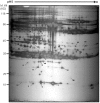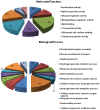Proteomic identification of novel differentiation plasma protein markers in hypobaric hypoxia-induced rat model
- PMID: 24842778
- PMCID: PMC4026414
- DOI: 10.1371/journal.pone.0098027
Proteomic identification of novel differentiation plasma protein markers in hypobaric hypoxia-induced rat model
Abstract
Background: Hypobaric hypoxia causes complex changes in the expression of genes, including stress related genes and corresponding proteins that are necessary to maintain homeostasis. Whereas most prior studies focused on single proteins, newer methods allowing the simultaneous study of many proteins could lead to a better understanding of complex and dynamic changes that occur during the hypobaric hypoxia.
Methods: In this study we investigated the temporal plasma protein alterations of rat induced by hypobaric hypoxia at a simulated altitude of 7620 m (25,000 ft, 282 mm Hg) in a hypobaric chamber. Total plasma proteins collected at different time points (0, 6, 12 and 24 h), separated by two-dimensional electrophoresis (2-DE) and identified using matrix assisted laser desorption ionization time of flight (MALDI-TOF/TOF). Biological processes that were enriched in the plasma proteins during hypobaric hypoxia were identified using Gene Ontology (GO) analysis. According to their properties and obvious alterations during hypobaric hypoxia, changes of plasma concentrations of Ttr, Prdx-2, Gpx -3, Apo A-I, Hp, Apo-E, Fetub and Nme were selected to be validated by Western blot analysis.
Results: Bioinformatics analysis of 25 differentially expressed proteins showed that 23 had corresponding candidates in the database. The expression patterns of the eight selected proteins observed by Western blot were in agreement with 2-DE results, thus confirming the reliability of the proteomic analysis. Most of the proteins identified are related to cellular defense mechanisms involving anti-inflammatory and antioxidant activity. Their presence reflects the consequence of serial cascades initiated by hypobaric hypoxia.
Conclusion/significance: This study provides information about the plasma proteome changes induced in response to hypobaric hypoxia and thus identification of the candidate proteins which can act as novel biomarkers.
Conflict of interest statement
Figures




References
-
- Wenger RH (2002) Cellular adaptation to hypoxia: O2-sensing protein hydroxylases, hypoxia-inducible transcription factors, and O2-regulated gene expression. FASEB J 16: 1151–1162. - PubMed
-
- Hightower LE (1993) A brief perspective on the heat-shock response and stress proteins. Marine Enviro Res 35: 79–83.
-
- Hernandez R, Blanco S, Peragon J, Pedrosa JA, Peinado MA (2013) Hypobaric hypoxia and reoxygenation induce proteomic profile changes in the rat brain cortex. Neuromolecular Med 15: 82–94. - PubMed
Publication types
MeSH terms
Substances
LinkOut - more resources
Full Text Sources
Other Literature Sources
Research Materials
Miscellaneous

